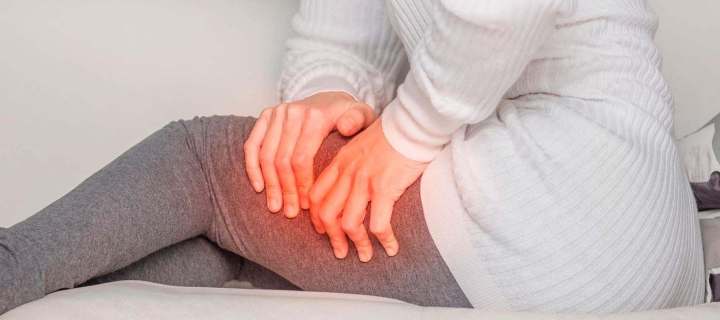While following a ketogenic diet, we must bear in mind that we are inducing the body to make a change in the source of energy consumption for its operation, which in itself leads to a change in the metabolic state.
This adaptation process for the body may have some peculiarities associated with side effects, including the more frequent appearance of muscle cramps in the legs or calves.
And, although the exact cause of cramps can be attributed to multiple factors, here are some aspects that can help you treat and prevent cramps on a ketogenic diet.

What causes cramps during a ketogenic diet?
1. Lack of electrolytes
Electrolytes are the source of minerals essential for the body to function. Through these, sodium, magnesium, chloride, potassium, calcium, phosphate and bicarbonate are mainly transported.
If any of these minerals are depleted, nerve cells become more sensitive, leading to pressure on the nerve endings, which tends to trigger muscle cramps. In this case, since carbohydrate intake is extremely low, electrolytes can lose their balance due to insufficient sodium (salt), potassium or magnesium in the body.
Similarly, when it comes to a process of adaptation to the ketogenic diet, the body loses more electrolytes because more urine is generated in response to the decrease in blood sugar levels; so muscle cramps related to electrolyte imbalance can become more frequent, especially during the first days of transition to the diet.

2. Dehydration
Due to reduced levels of insulin and increased sodium excretion, the amount of urine produced increases, and this increased urination is another potential cause that increases dehydration of the body and, with it, the risk of cramps.
The level of dehydration in the body can vary depending on the food and beverages ingested in the last few meals, the amount of activities in your daily routine, sex, the weather, the general state of your health and age. Therefore, it is important to consume necessary amounts of fluids that help the muscles contract and relax during your activity and that the muscle cells can stay hydrated and less irritable.

3. Other possible causes
The use of some medications, such as diuretics, asthma medications, and statins, are associated with an increased risk of leg cramps. This is demonstrated by a study carried out in Canada, in which it was determined that the use of these medications can cause or worsen the symptoms of experiencing night cramps in the legs . (Scott, Garrison, Colin, Dormuth and Morrow, 2012).
Also medical conditions such as liver and kidney failure or low blood pressure (hypotension), and smoking are associated with symptoms of leg cramps. In addition, muscle tension caused by strenuous physical activity or excessive effort can generate cramps , either by exercising for longer than usual, or at an intensity that is too high to which our body was previously accustomed.

How to treat and prevent cramps during a ketogenic diet
Start by making a few simple diet and lifestyle changes; like hydrating properly, eating nutritious, electrolyte-rich foods, and progressively engaging in physical activities can help treat and prevent cramps on a ketogenic diet . We give you some recommendations in this regard:
1. Increase in electrolytes
To increase electrolytes during a ketogenic diet , we suggest the following measures:
- Eat Potassium-Rich Foods: Avocados, Swiss chard, spinach, onions, tomatoes, beet greens, and mushrooms are keto-friendly, potassium-rich foods that help balance electrolyte flow.
- Eat foods rich in magnesium: pumpkin seeds, walnuts, cashews, kale, arugula, broccoli and oysters, they are low in carbohydrates and high in magnesium to help control electrolyte levels .
- Get enough salt: Salting food helps reduce the chances of electrolyte imbalance. Consider incorporating salty bone broth into your diet to ensure a high sodium source.
- Take an Electrolyte Supplement – Taking a magnesium, potassium, or multimineral supplement may be a good idea for those new to a ketogenic diet.

2. Follow correct hydration
Cramps are generally believed to be due to loss of potassium; however, the solution has always been in the correct hydration. Therefore, the first line of defense is to begin physical activity well hydrated . When the activity lasts for more than 60 minutes, it is advisable to drink sports rehydration drinks, which helps to replace carbohydrates and minerals.
In the same way, if the physical activity is carried out in a very hot and humid climate, sweating must be efficiently fought to avoid excessive sodium loss. Sodium is key to maintaining blood volume and promoting proper nerve stimulation for muscle work.
Consuming a glass of milk or a fruit smoothie is a recommended repowering at the end of physical activities that also contributes to the replenishment of minerals.

3. Additional recommendations to prevent cramps
- Stretching before and after using any muscle for an extended period and stretching before bed can help prevent cramps while you sleep.
- Adjusting for a gradual progression to training helps give your body time to adjust to the increased intensity.
- Avoid drinking alcohol, coffee, and smoking.
If after taking all these precautions you are still suffering from cramps, it is advisable to visit a health professional to make sure you do not experience a more serious health condition.
References
- Kubala, J. (2020) How to Prevent Leg Cramps on the Keto Diet. For Healthline. [Revised March 2020]
- Scott, R., Garrison, SR., Colin, R., Dormuth, ScD., Morrow, MA and Richard, L. (2012) Nocturnal leg cramps and prescription use that precedes them: A sequence symmetry analysis. Recovered from Pubmed. Doi: 10.1001 / archinternmed.2011.1029